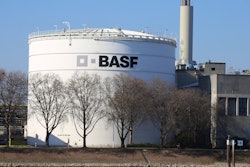Nitrogen pollution flowing out of Iowa into the Gulf of Mexico has grown by almost 50 percent over nearly two decades, despite hundreds of millions of dollars spent to prevent soil nutrients from entering the state’s waterways.
A University of Iowa study shows the state’s contribution to the Gulf’s dead zone—a region of oxygen-depleted water off the Louisiana and Texas coasts—spiked 47 percent to 618 million pounds in 2016.
Most of the nitrogen pollution stems from farming, although a significant portion can be attributed to urban wastewater and industrial operations. Nitrogen expelled from these locations flows into the Mississippi and Missouri rivers, which make their way to the Gulf of Mexico.
Excess nitrogen runoff from rivers in Iowa and other states can stimulate an overgrowth of algae in the Gulf of Mexico. The overgrowth then sinks and decomposes in the water, consuming oxygen and depleting the supply available to marine life. Oxygen levels in the zone are so low that fish and other marine life either leave or die, which severely threatens the Gulf’s fishing industry.
“The Gulf’s summer hypoxic (dead) zone continues to put important habitats and valuable fisheries under intense stress,” said Rob Magnien from the National Oceanic and Atmospheric Administration (NOAA).
Iowa is an agricultural leader in corn, soybean, pork, egg, and beef production. This intense farming of carbohydrates and proteins, however, is not the main reason for the increased nitrogen impact, according to UI scientists.
Experts speculate that the increased nitrogen levels could be coming from drainage tiles, as Iowa’s drainage tile systems have expanded in order to improve crop yields by removing excess water from fields. Water carried away by the tiling system misses cleansing that would naturally occur by filtering through soil or the roots of trees, shrubs, and grasses along streams.
Last year, Iowa invested $420 million in water quality improvements, helping farmers plant cover crops, build terraces, and implement other conservation practices that hold ground nutrients in place. Despite these investments, the expansion of drainage tile systems, along with increased hog, cattle, and chicken feeding operations—which provide manure to fertilize crops—outweighed these efforts and contributed to high levels of pollution.
“We’ve been pouring state and federal money into cutting nutrient pollution for decades, and this highlights the fact that the voluntary approach is not working,” said Jennifer Terry, executive director of the Iowa Environmental Council.
The results of this study come just as Iowa marks the five-year anniversary of the Iowa Nutrient Reduction Strategy, a plan designed to cut nitrogen and phosphorous levels from Iowa into the Gulf dead zone by 45 percent. Environmentalists say the study raises questions about the effectiveness of Iowa’s approach to improving water quality and its reliance on voluntary agricultural compliance.
“We need a dramatic increase, a rapidly-scaled up increase in conservation practices and more funding,” said Cindy Lane, the Iowa Environmental Council’s water program director.
Severe nitrogen pollution in water can create problems for both people and animals alike—even beyond the Gulf’s dead zone. High phosphorous levels can lead to toxic algae booms that can soil lakes, rivers, and streams, potentially killing pets and making people ill.
Increased levels of nitrogen pollution also leads to a higher cost for utilities for nitrate removal. In 2016, the Des Moines Water Works utility invested $80 million to remove nitrates to meet federal drinking water standards. It spent $1.5 million in 2015 to run its nitrate removal equipment a record number of days to ensure safe drinking water.
The study also shows that over the past 18 years, Iowa, on average, contributed 29 percent of the total nitrogen headed to the Gulf from the Mississippi-Atchafalaya River basin—a massive watershed that includes all or part of 31 states.
Iowa’s impact was even greater in other watersheds. The state averaged 45 percent of the nitrogen levels going into the Upper Mississippi River basin, and 55 percent of the nitrogen going into the Missouri River basin.
“The way that pencils out is that the amount of water coming from Iowa has seven times more nitrates than the rest of the Missouri River watershed,” said Chris Jones, a research engineer at the University of Iowa’s IIHR-Hydroscience & Engineering.
Iowa’s nitrogen levels have been above the 2003 value for 10 consecutive years, the study says. If Iowa’s contributions were removed, the total nitrate load in the three basins would be steady or declining.
The Gulf Hypoxia Task Force, made up of federal, state, and tribal leaders, have a goal to reduce the dead zone to 1,900 square miles by 2035. The deadline was extended from 2015.
Last year, the dead zone set a record, which, at 8,776 square miles, was more than four times the goal size. Without Iowa, the Gulf’s overall nitrate loads would have declined 43,400 tons over 18 years, based on five-year annual averages. Instead, nitrate levels grew by 52,000 tons.
“Iowa has a dominant role in this Gulf hypoxia issue,” said Keith Schilling, a UI researcher and co-author of the study. “Let’s invest the resources here, where we really need it. If we solve Iowa, we solve the Gulf.”























